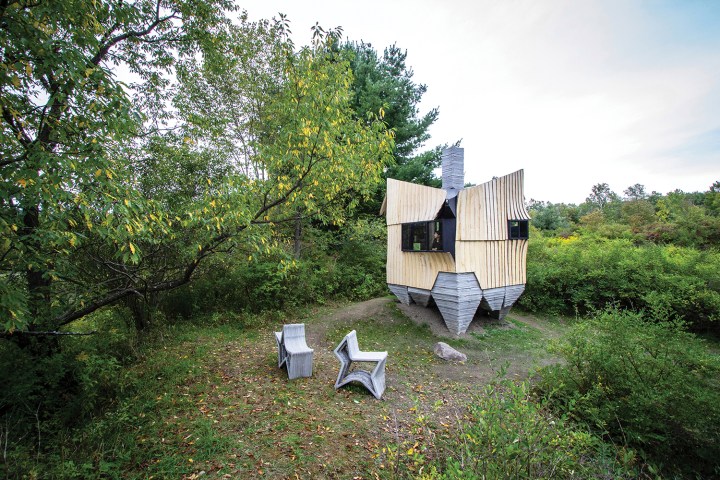
As houses of the future go, Ashen Cabin doesn’t look particularly futuristic. Anyone expecting a The Jetsons-esque vision of robot assistants, indoor conveyor belts, and flying vehicle garages is going to be sorely disappointed; this rustic log cabin, boasting spectacular views of three state forests in Ithaca, NY, doesn’t even have electricity or running water. A camping stove, basic sink, and some achingly beautiful views are what count for luxuries.
But Ashen Cabin is a vision of the future — and it’s a compelling one. Looking at it up close — a journey that requires the visitor to follow a winding path through the hills; the cabin gradually revealing itself, chimney first, among the foliage — makes clear immediately that this is not a typical log cabin. With odd geometries and sitting on squat concrete legs, Ashen Cabin doesn’t look as if it was designed and built by a human in the 21st century.
Certainly not by anyone looking for a conventional log cabin. It’s more like the kind of cabin that a reclusive Harrison Ford might be found living in at the end of some future Blade Runner sequel. Or the type of “back to nature” retreat a Google DeepDream-style neural network would imagine if you trained it exclusively on a dataset of Grimms’ Fairy Tales.
Making the log cabin a reality took two dedicated creators, several years, and countless hours of research and innovation. Oh yes, and an enormous 3D printer, some 3D scanning tech, and a construction robot bought off eBay, too. But as much of an anomaly as it may be here in 2020, nestled on a ridge in one of the most rural, idyllic parts of New York State, one day a whole lot of buildings may trace their lineage back to Ashen Cabin. Seriously.
An experimental design company

“The Ashen Cabin is a project in which we’re testing some of our research ideas and translating them into architecture,” Sasa Zivkovic told Digital Trends. “That, to us, was the exciting part about it.”
The cabin is designed and constructed by HANNAH, an experimental design office co-founded by Zivkovic and Leslie Lok. They are both assistant professors at the nearby Cornell University where Zivkovic heads up a research group called the Robotic Construction Laboratory. As its name implies, this multidisciplinary group focuses on, simply put, robots that build houses. Meanwhile, Lok’s teaching and research explore robotic fabrication at the urban and housing scale.
“[This project allowed us to begin] to discover a new architectural language working with 3D printing and robotically fabricated wood,” Lok told Digital Trends. “This became a very important component. I think that’s what contributed to the unique looking design of the building. We knew we weren’t going to be using standardized materials.”
Zivkovic and Lok began working together on new ways to build buildings several years ago with a project called Additive Architectural Elements. At the time, they hadn’t graduated to a full structure like a cabin. Instead, they were interested in answering the question: What kind of a design for housing components would a 3D printer create? As they noted, the 3D printer is often thought of as characterless.
We wouldn’t, for instance, ask what kind of a novel an inkjet printer would print; we’d just write a novel and then print it. But 3D printing — and, specifically, 3D-printed concrete — opens up some unusual avenues for designers who don’t have to limit themselves to simply printing replicas of the kinds of designs that may have existed in the pre-3D printing world. Zivkovic and Lok printed floors, columns, doors, windows, walls, and ceilings — all with a view to analyzing the integrity, personality, limitations, and formal rigor of the form.
It was the basis of a new style; one that the pair refer to as “Robot Brutalism,” after the fiercely modernist 1960s and 70s architectural style which flaunted modern construction methods, such as concrete. Of course, some of the new construction technologies available to the pioneers of Robot Brutalism far outstrip those that existed half a century ago.
Odd geometries

Work on the Ashen Cabin began in 2017. The team began by 3D-printing a concrete shell for the cabin using a special self-built 3D printing system that saves on the carbon footprint of ordinary concrete construction by using the absolute minimum quantity required. This system, which extrudes a cement-like mixture in layers, took about two weeks in total to create a basic structure.
The wooden planks laid on top of this shell were similarly high tech — even if they might not immediately look it. Glancing at the strange wavy planks used by the designers, you’d be forgiven for initially thinking that they were not cut particularly precisely. Hardly any of the planks are entirely straight, with kinks and odd-shaped bends like a vertical line degraded by a VHS copy-of-a-copy-of-a-copy. In fact, they were perfectly measured; they just happen not to have been cut into straight lines.

“[One of the reasons mature ash trees aren’t used for construction] is that they aren’t exactly the straightest of trees,” Zivkovic said. “The ash tree has irregular geometries, so it’s very difficult to process in a regular sawmill. We developed a process with robotic fabrication technology and 3D scanning that enables us to use these otherwise-wasted ash trees for construction purposes.”
Zivkovic and Lok scanned in three dimensions every piece of wood at their disposal. This allowed them to get to grips with the various “odd geometries” of wood, and figure out how best to cut them. The high-precision task of carrying this out was performed using a modified robotic arm the pair discovered on eBay. It had previously been used to build cars for General Motors, but Zivkovic and the Robotic Construction Laboratory team repurposed it; reprogramming it so that it was able to methodically saw and shape wood that would normally be extremely difficult to cut using standard milling tools.
All about sustainability

As with the CO2-saving 3D printing approach, sustainability was one of HANNAH’s principal concerns when it came to the wood. This wasn’t ordinary ash, but rather beetle-damaged ash which had been attacked by the Emerald Ash Borer, an insect that kills ash trees as part of its reproductive cycle. Since being discovered in the U.S. in 2002, the Emerald Ash Borer has spread into 35 states and several Canadian provinces. Today, Zivkovic estimates that there are 8.7 billion ash trees threatened by this infestation.
“For the most part, [the trees are] either left to die, which releases carbon into the atmosphere, or they’re being used as firewood,” he said. “To us, this is sort of a tremendous missed opportunity.”
With a full record of all the inventory at their disposal, Zivkovic and Lok then went through and figured out how best to piece the cabin together. For larger buildings in the future, Lok said it would be possible for architects to turn over the 3D inventory data to algorithms that could optimize how it could all be best fitted together.

“I think one day it would be possible to scan an entire forest,” Lok said. “Then we could develop algorithms that optimize how you use these trees in a project. This is somewhere computation would be really, really helpful.”
The future of sustainable home construction
The Ashen Cabin is exciting for all kinds of reasons. The idea of a new Robot Brutalist design language is exhilarating because of what it suggests about the new emerging forms of architecture that are only now becoming a reality. But the reason it could lay the groundwork for something world-changing is because of the way that it utilizes these technologies, along with materials from the natural world, to create something that is sustainable and scalable.
It is difficult to estimate a total budget for the project. The material costs of the cabin are reasonably low, in the vicinity of $15,000. But this does not include labor, prototyping, and R&D. But, as with anything, costs will come down as more work is carried out.
The material costs of the cabin are reasonably low, in the vicinity of $15,000.
“We think that both technologies — 3D printing with concrete, and general robotic timber manufacturing — will have cost advantages in the future,” Zivkovic said. “However, it’s impossible to precisely quantify what those will be. The more widely we implement those technologies, the more economic advantages we will see. Ashen Cabin is a prototype.”
No, we probably won’t all live in stunning log cabins with beautiful views of nature (although the thought isn’t without its appeal). However, the concept of being able to quickly build new types of housing at low cost and using materials that would otherwise go to waste is incredibly appealing. Hopefully, it won’t be long before the duo creates their next building. And the one after that.






